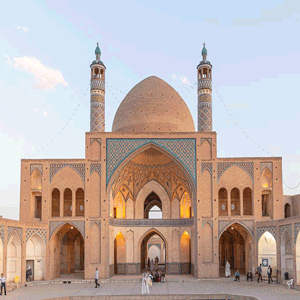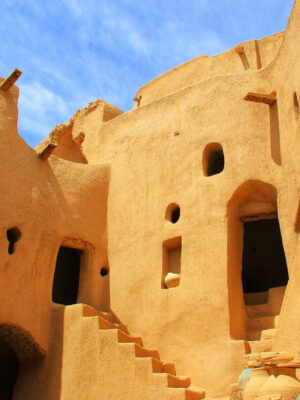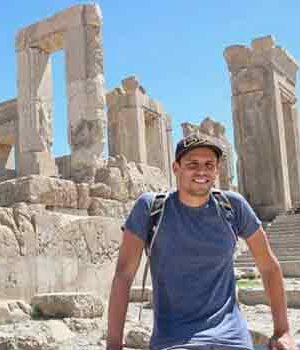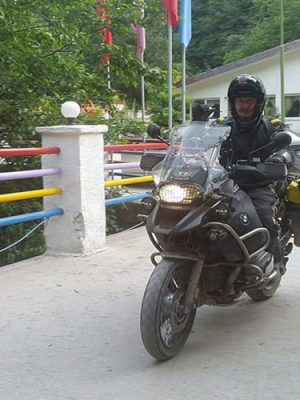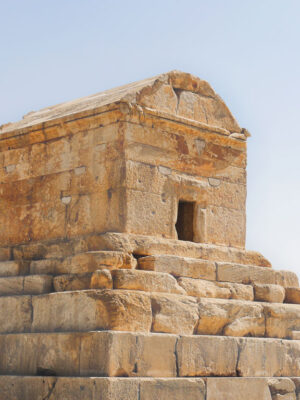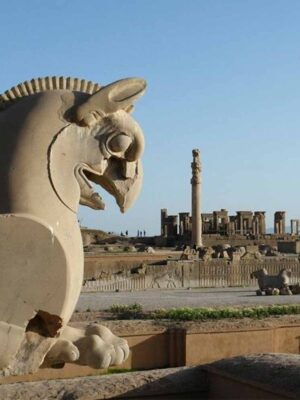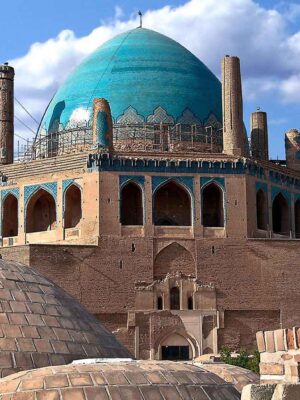Bisotun
Located on ancient trade routes, near the city of Kermanshah in western Iran is Bisotun or Behistun, a site that includes remains from prehistoric times, as well as those from Median, Achaemenid, Sassanian, and Ilkhanid periods The main monument of this archaeological site is a large rock relief and cuneiform inscription authored by Darius I, The Great, when he took the reign of the Persian Empire in 521 BC. The rock relief (15 meters long by 25 meters wide, and 100 meters up a limestone cliff at Mount Behistun) shows Darius stepping on the chest of a figure who lies on his back before him. The inscription (about 1,200 lines) is written in three different cuneiform script languages: Old Persian, Elamite, and Babylonian (a variety of Akkadian).
The inscription begins with a brief autobiography of Darius, including his ancestry. Darius details the lengthy sequence of events following the deaths of Cyrus the Great and his son, Cambyses II. It includes the 19 battles Darius fought and the rebellions he overcame throughout the Persian Empire until 521 BC. The inscription states in detail the rebellion and upheaval that resulted from the deaths of Cyrus the Great and his son Cambyses II in which several impostors in various cities throughout the empire, falsely proclaimed kinghood following Cyrus’s death. Darius the Great proclaimed himself victorious in all battles during the period of upheaval, attributing his success to the “grace of Ahura Mazda” (also known as Hourmazd, Hormazd, and Hurmuz, the creator and highest deity of Zoroastrianism).

In 1598, the Englishman Robert Sherley saw the inscription during a diplomatic mission to Persia, and brought it to the attention of Western European scholars such as the German surveyor Carsten Niebuhr who visited the site around 1764 and published a copy of the inscription in the account of his journeys in 1778. Niebuhr’s transcriptions were used by Georg Friedrich Grotefend and others in their efforts to decipher the Old Persian cuneiform script.
The statue of Hercules which was discovered in 1957 is also located at Mount Bisotun. The statue was sculpted in 153 BCE for a governor of the Seleucid Empire or the Parthian Empire. Hercules is lying on a 2 meter long platform and holds a bowl in his left hand. He has his right hand on his foot. The statue is 1.47 meters long and is attached to the mountain. The head of the statue was stolen twice, but recovered again.
There are also five caves near Bisotun dating from the Paleolithic to Epipalaeithic periods. One of the caves by the name of Ghar Parau is 3,050 meters above sea level, and is the highest cave in the world.
Bisotun
Located on ancient trade routes, near the city of Kermanshah in western Iran is Bisotun or Behistun, a site that includes remains from prehistoric times, as well as those from Median, Achaemenid, Sassanian, and Ilkhanid periods The main monument of this archaeological site is a large rock relief and cuneiform inscription authored by Darius I, The Great, when he took the reign of the Persian Empire in 521 BC. The rock relief (15 meters long by 25 meters wide, and 100 meters up a limestone cliff at Mount Behistun) shows Darius stepping on the chest of a figure who lies on his back before him. The inscription (about 1,200 lines) is written in three different cuneiform script languages: Old Persian, Elamite, and Babylonian (a variety of Akkadian).
The inscription begins with a brief autobiography of Darius, including his ancestry. Darius details the lengthy sequence of events following the deaths of Cyrus the Great and his son, Cambyses II. It includes the 19 battles Darius fought and the rebellions he overcame throughout the Persian Empire until 521 BC. The inscription states in detail the rebellion and upheaval that resulted from the deaths of Cyrus the Great and his son Cambyses II in which several impostors in various cities throughout the empire, falsely proclaimed kinghood following Cyrus’s death. Darius the Great proclaimed himself victorious in all battles during the period of upheaval, attributing his success to the “grace of Ahura Mazda” (also known as Hourmazd, Hormazd, and Hurmuz, the creator and highest deity of Zoroastrianism).

In 1598, the Englishman Robert Sherley saw the inscription during a diplomatic mission to Persia, and brought it to the attention of Western European scholars such as the German surveyor Carsten Niebuhr who visited the site around 1764 and published a copy of the inscription in the account of his journeys in 1778. Niebuhr’s transcriptions were used by Georg Friedrich Grotefend and others in their efforts to decipher the Old Persian cuneiform script.
The statue of Hercules which was discovered in 1957 is also located at Mount Bisotun. The statue was sculpted in 153 BCE for a governor of the Seleucid Empire or the Parthian Empire. Hercules is lying on a 2 meter long platform and holds a bowl in his left hand. He has his right hand on his foot. The statue is 1.47 meters long and is attached to the mountain. The head of the statue was stolen twice, but recovered again.
There are also five caves near Bisotun dating from the Paleolithic to Epipalaeithic periods. One of the caves by the name of Ghar Parau is 3,050 meters above sea level, and is the highest cave in the world.






